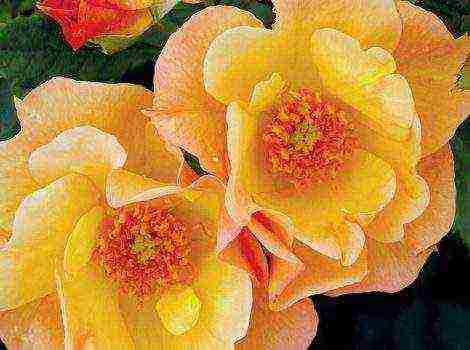Content
- 1 The best early varieties of cherries
- 2 The best mid-season cherry varieties
- 3 The best late varieties of cherries
- 4 Cherry varieties: description and photo
- 5 1 Characteristics of varieties
- 6 2 By the rate of ripening
- 7 3 By the first year of fruiting
- 8 4 By pulp
- 9 5 To taste
- 10 6 Cherry zoning
- 11 7 Southern varieties
- 12 8 Winter-hardy varieties for the middle zone of the country
- 13 9 Compact winter hardy cherries
- 14 10 Growing in the Urals and Siberia
- 15 11 Self-fertile cherries
Review of the best varieties of cherries - according to gardeners' reviews
Sweet cherry is a sweet and aromatic southerner with early ripening. There is a high temptation to plant a slender tree on your site and feast on fruits with delicate pulp. According to the experience of gardeners in the Moscow Region, the Middle Belt and the Southern Urals, growing sweet cherries and obtaining a rich harvest is akin to art. The main problems that arise when planting a thermophilic tree in a harsh climate are associated with insufficient winter hardiness and susceptibility to diseases. It is these characteristics that you need to pay attention to when choosing the best cherry variety for the Moscow region.
Sweet cherries are self-fertile, therefore a pollinator variety with the same flowering period is needed to set fruits. Planting one tree is not enough. But as an alternative, you can graft a different variety into the crown of an adult tree. Sweet cherries are vigorous trees, and for normal development they are planted at a distance of 4 - 5 m. They form a powerful, deeply penetrating root system and do not tolerate close passage of groundwater. These features must be taken into account when assessing your site so that the planted trees do not have to be uprooted after a few years.
Read more about the best varieties of cherries for the Moscow region and the Middle Strip, the Urals, the southern regions in our rating, compiled according to reviews of experts and experienced gardeners.
The best varieties of cherries - Top 8
The best early varieties of cherries
|
Iput 500 (one-year-old in a container (ZKS)) Our rating of the best varieties of sweet cherries is opened by an early variety that ripens in mid-June. The tree is 4 - 6 m high. The crown is broad-pyramidal, dense. Fruits are leveled, weighing from 5 to 10 g, blunt-hearted, black-red, with dark red tender pulp of medium density, the separability of the stone is medium. The taste is juicy and sweet with sourness. Ripe fruits have an appetizing, attractive, presentation. With a lack of heat and sun, the fruits acquire a tart taste and pronounced sourness. In favorable years, 25 - 35 kg are harvested from one tree. Winter hardiness of this cherry variety is good, but in severe winters there is a slight freezing of the growth and average damage to flower buds. After returnable spring frosts, no more than 60% of the ovaries are damaged. Disease resistant. Recommended in the Central and Central Black Earth regions. In the Moscow region, Nizhny Novgorod, Penza and Samara, gardeners note good adaptive qualities. Pollinating varieties: Revna, Tyutchevka, Bryanskaya rozovaya, Ovstuzhenka and Raditsa. Main pluses:
Minuses:
|
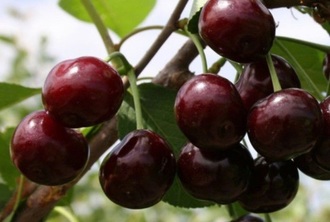 9.8 / 10 Rating Reviews A good, very early cherry variety, does not get sick. It ripens with me with garden strawberries. The fruits are large, but watery and sour.
|
|
Chermashnaya 850 (two-year-old in a container (ZKS)) Yellow cherry with early ripening. The tree is 4.5 - 5 m high. The crown is spherical, raised, not thickened.Fruits are one-dimensional, even, rounded, weigh on average 4 - 4.5 g, pale yellow, with a thin and dense skin. Dessert taste, sweet with a slight sourness. The pulp is juicy and tender, yellow in color, the separation of the stone is good. Uncomfortable ripening is observed. The average yield of an adult tree is 15 - 20 kg. The variety is absolutely self-fertile, that is, it will not tie a single fruit without a pollinator. For pollination, plant Fatezh, Raditsa or Bryansk pink. Differs in early maturity: fruiting begins 3-4 years after planting. Winter hardiness of wood is at the level of average, flower buds can be damaged by spring frosts. Recommended for growing in the Black Earth region. There is a positive experience of growing in the Moscow region, however, gardeners, after harsh winters, note the appearance of frost holes on the bark. Main pluses:
Minuses:
|
 9.7 / 10 Rating Reviews Nice yellow cherry, the tree is just strewn with berries. I like the fact that when the neighboring red cherry ripens, our Chermashnaya does not attract starlings.
|
|
Ovstuzhenka 420 (one-year-old with open root system) A good variety of cherries with early fruit ripening. Trees 3 - 4 m high, with a dense, raised, spherical crown. The short stature of the trees makes harvesting easier and protects the fruit from starlings. Fruits are round, deep burgundy, weigh 4 - 7 g, the flesh is dark red. They are easily separated from the stalks, with a dry separation, the separation of the bone from the pulp is good, they do not crack. The taste is juicy and sweet, without astringency. The yield of one tree with good care and without damage is 50 - 60 kg, in the first years of fruiting - 10 - 15 kg. Partially self-fertile, therefore, even without a pollinator, it sets a small (about 5%) number of fruits. Pollinating varieties: Revna, Bryanskaya pink, Iput, Tyutchevka, Raditsa. Differs in high winter hardiness and frost resistance, including flower buds and ovaries. Shows high resistance to coccomycosis and moniliosis, moderately affected by clasterosporiosis. The variety is zoned in the Central region. There is a good experience of growing in Chelyabinsk and in the Middle lane. Main pluses:
Minuses:
|
 9.7 / 10 Rating Reviews In general, we are satisfied with the variety. Good classic cherry in appearance and fruit taste. It does not cause problems and is always strewn with berries.
|
The best mid-season cherry varieties
|
Fatezh 850 (two-year-old in a container (ZKS)) The fruits ripen on average, from the second decade of July. The tree grows up to 4 - 5 m. The crown is sprawling, spherical, of medium density, needs to be shaped to maintain a compact shape. The lower branches droop under the weight of the harvest. The fruits are aligned, well-rounded, weighing 3.8 - 6 g, yellow with a large red blush, with a dry separation from the stalk. The taste is juicy and sweet with a pleasant sourness. The pulp is pink, firm. The bone is easily separated from the pulp. Up to 50 kg are harvested from one adult tree, in the first years of fruiting, productivity is at the level of 10 - 30 kg. This cherry variety is recommended for cultivation in the Central region, Moscow region. Positive cultivation experience has been obtained in many areas of the Middle Belt. Chermashnaya, Revna, Ovstuzhenka, Raditsa or Iput are planted as pollinators. Main pluses:
Minuses:
|
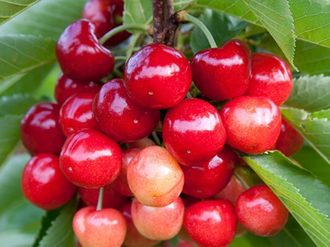 9.8 / 10 Rating Reviews The fruits are small, but the cherry harvest pleases, and even unripe fruits are quite sweet.
|
|
Gift to Stepanov 420 (one-year-old with open root system) A new medium-late sweet cherry variety of the Bryansk selection. The tree is 4 - 5 m high, with a pyramidal, sparse crown. Fruits are rich red or burgundy, weighing 3.5 - 4.5 g, aligned, blunt-hearted, with dark red, juicy, cartilaginous pulp and delicate skin. Dessert taste, estimated at 4.9 - 5 points. The peduncle comes off easily, the stone is separated well. In the description of this cherry variety, good resistance to major diseases and high winter hardiness are declared. In the State Register since 2015, zoned for the Central Region. Also, gardeners grow this cherry variety in Nizhny Novgorod and Chelyabinsk. Main pluses:
Minuses:
|
 9.7 / 10 Rating Reviews One-year cherry seedling quickly took root and started to grow, it adapts well to growing conditions.
|
The best late varieties of cherries
|
Bryansk pink 850 (two-year-old in a container (ZKS)) A versatile late ripening cherry variety. The tree is 4 - 4.5 m high and has a slow growth rate. The crown is wide-pyramidal, raised, moderately thickened. Fruits are pink with a tan and a characteristic speck, weigh on average 4 - 5.5 g, regular rounded shape, with a dry separation, do not crack when waterlogged. The pulp is dense, yellow, with weak cartilage. Light juice. The separation of the bone from the pulp is average. The taste is juicy and sweet, with a slightly pronounced bitterness. One tree bears an average of 20 - 30 kg of fruit. Ovstuzhenka, Tyutchevka, Iput and Revna are suitable pollinators. Resistance of the trunk and skeletal branches to frost breakers is observed. High winter hardiness of wood and flower buds, sensitivity to spring frosts. High resistance to coccomycosis, moniliosis and clasterosporiosis. Recommended for cultivation in the Central region, widespread throughout the Middle zone. Main pluses:
Minuses:
|
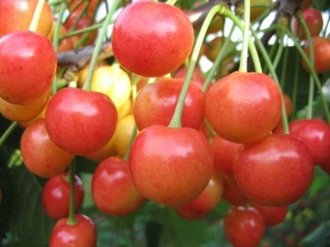 9.8 / 10 Rating Reviews Good cherry for the Moscow region, the fruits are smallish, but sugary-sweet. The variety is not sore and not capricious, but the yield is stable.
|
|
Jealous 730 (two-year agronomic grid) A good proven variety of late-ripening cherries. The tree is fast-growing, 4 - 5 m high, with a sparse pyramidal crown. It lends itself well to all types of shaping. Fruits are beautiful, broadly rounded, weigh from 5 to 8 g, dark red, almost blackening when ripe, with dry separation, transportable. The pulp is rich red, dense. The bone is separated well. The taste is juicy and sweet, gaining 4.8 - 5 points during tasting. The average productivity of one tree is 30 kg. The variety is partially self-fertile: without a pollinator, it sets up to 5% of the potential number of fruits. Good pollinators are Ovstuzhenka, Tyutchevka, Raditsa, Iput. The stem and skeletal branches are not affected by frostbites. Shows high winter hardiness and good resistance to recurrent frost. Differs in good immunity. Zoned in the Central Region, but actively grown throughout the Middle Lane. Main pluses:
Minuses:
|
 9.8 / 10 Rating Reviews A young tree is always healthy and strong, even after a harsh winter it looks better than other sweet cherries.
|
|
Tyutchevka 420 (one-year-old with open root system) Late sweet cherry, ripens at the end of July. The tree is medium-sized, 4 - 6 m high. The crown is spherical, sparse, moderately spreading.Fruits weigh from 5 to 7.4 g, rounded with a wide base, red with specks. The pulp is firm, red. The separation of the bone from the pulp is average. Fruits are transportable, with dry separation. The taste is excellent. Up to 40 kg can be harvested from one tree annually. The variety is partially self-fertile. Iput, Raditsa, Revna or Ovstuzhenka are planted for pollination. In the conditions of the Moscow region, gardeners note the cracking of berries when rainy weather is established during the ripening period. It is moderately affected by clasterosporium and coccomycosis, very rarely - by moniliosis. In severe winters, the trees freeze slightly. Spring frosts during the flowering period can destroy up to 70% of the ovaries. Zoned for the Central region, successfully grown in the Middle zone and in the South Urals. Main pluses:
Minuses:
|
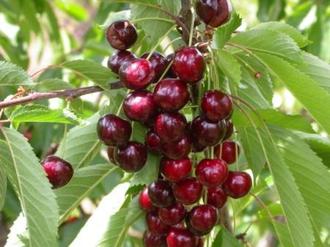 9.7 / 10 Rating Reviews The best cherry for the Moscow region, in my opinion. Surprises with high frost resistance. I rate the fruits at 5 points, even unripe sweet ones, and the children eat with pleasure.
|
Members of the forum also recommend cherry varieties in reviews: Rossoshanskaya rose, Bryanochka, Teremoshka, Milan, Pamyat Astakhov, Raditsa and Valery Chkalov. When choosing cherries for their site, gardeners of the Middle Lane often prefer medium-sized and winter-hardy varieties.
For cherries, as for a heat-loving culture, spring planting is desirable. They buy seedlings with unblown buds. If the leaves open in the warmth, then the seedling must be urgently planted in the ground in order to prevent the drying of the shoots and roots. In regions with a protracted spring, it is better to buy planting material with a closed root system: in a container, the tree will painlessly endure the wait for planting. The planting hole is prepared in the fall, and the soil mixture for backfill is stored in a closed unheated room. These measures will allow you to land at the earliest possible date.
With cherries, there are very frequent cases of re-grading, when southern varieties are passed off as zoned. Cherry seedlings are best bought from trusted stores, local nurseries or reputable private gardeners.
We wish you a good harvest!
Attention! The reliability of the information and the results of the ratings is subjective and does not constitute advertising.
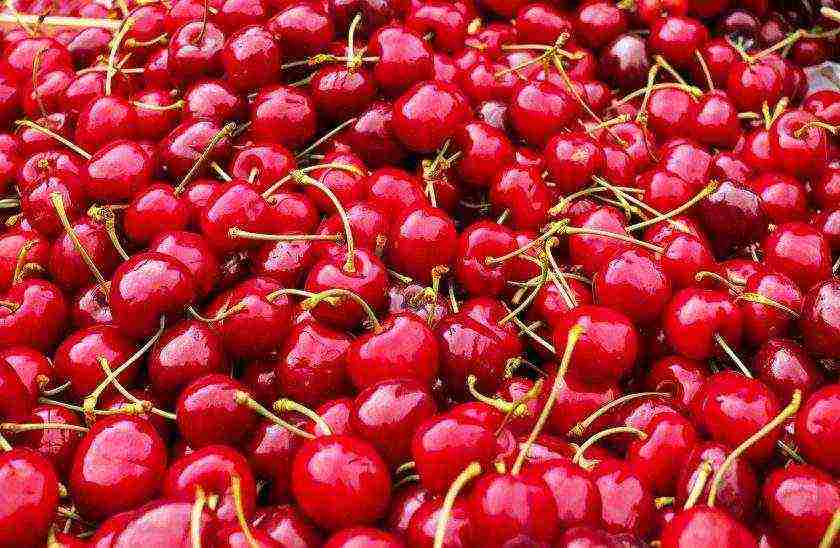
Let's talk about cherries and describe the best varieties of it. There are sweet, slightly sour, crispy, soft, different colors. Thanks to selection, every year new forms of this amazing tree are bred.
Cherry varieties: description and photo

To get a bountiful harvest, it is necessary to choose varieties taking into account the peculiarities of the climate in a particular region. So, frost-resistant varieties are suitable for central Russia, and more thermophilic plants can be grown in Ukraine.
Unlike cherry, sweet cherry ripens much earlier, its tasty and aromatic fruits can already be enjoyed in early summer - June. It is a real source of useful trace elements (iron, iodine, potassium, magnesium, calcium) The fruits of the plant grow in the form of a single-celled drupe with a juicy pericarp.
Taking into account the late period of emergence of cherry fruit buds from the state of forced dormancy, the yield of this crop is characterized as stable. Another advantage of cherries is the presence of reliable protection from return frosts in anthers and pistils, which is not the case with cherries.
The leaves of the fruit crop are very large in size, they are distinguished by an elongated-oval or elongated-obovate shape and brown glands on the petioles.
Most of the cherry varieties require additional pollination. Therefore, when choosing a tree, it is recommended to study its description, which indicates the necessary pollinators.
It is not so often possible to find self-fertile varieties on the market. They can be purchased by order from abroad. Among the popular hybrid forms, there are: Alex, Peter, Stella, Sandor, Sweet Hart.
Below is a list of the most popular cherry varieties with descriptions and photos.
Iput
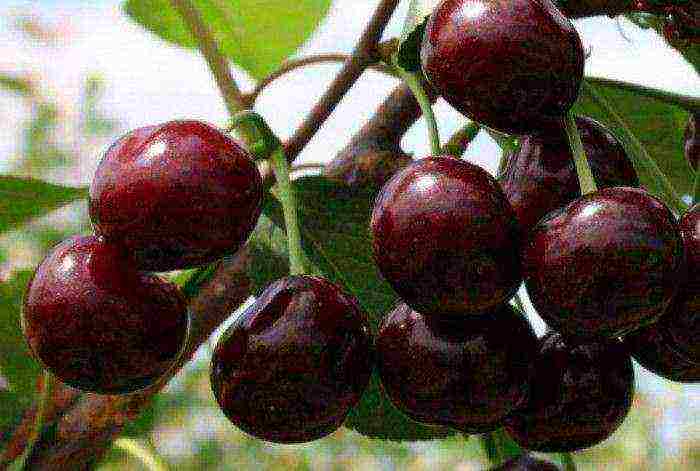
Read also:Everything about planting and growing cherries - from choosing a seedling to harvesting (Photo & Video) + Reviews
PROS:
- Average height
- Early ripening of fruits
- High yield (up to 30 kg of berries are removed from one tree)
- High palatability (fruits have black color and dark red juicy pulp)
- The berry is removed with the stalk
- The crop is not afraid of transportation
- High degree of resistance to fungal infections
- It tolerates low temperatures well (up to -28 degrees)
MINUSES:
- Average early maturity (yields a harvest 5 years after planting)
- With an excess of moisture, the fruits crack
- The pulp is difficult to separate from the bone
According to reviews:
It is recommended to plant it in pairs together with Revna, since these varieties are inter-pollinated. It turned out to be very tasty, large, the first harvest is already 3 years old. It grows quickly, almost one-meter increments per year. turned out to be not dark red, but just red, maybe because of the lack of the sun.
Valery Chkalov

PROS:
- Early ripening of berries
- Large fruit size (weight up to 6-8 g)
- High taste characteristics of fruits (the pulp is dark red in color, juicy, semi-gristly consistency)
- Dessert type
- Universal use of berries
- High level of productivity (62 kg per tree on average)
- High level of frost resistance (-23.5 degrees
MINUSES:
- Height (up to 5 m)
- Wet separation of the berry from the stalk, juice is released
- The level of early maturity is medium (yields a harvest for 5 years)
- Self-infertile variety
- Average level of resistance to diseases, including fungal
Pollinators: Dnieper, Bigarro Burlat, April, June early Skorospelka
Jealous

Read also:Cherries: what you need to know about them in order to get generous harvests. Description, planting and care (25 Photos & Videos) + Reviews
PROS:
- Medium-sized tree, compact
- The crown has no sharp forks
- Unpretentious in care
- Fruits are distinguished by high taste and consumer qualities.
- Due to the dense skin, the crop is transportable over long distances
- High level of frost resistance (up to -30 degrees)
- High resistance to frost crack, sunburn
- Resistance of the tree to fungal infections
MINUSES:
- Medium late harvest ripening
- Self-infertility
Its best pollinators: Raditsy, Compact, Iput, Venyaminova, Tyutchevka, Ovstuzhenki
Large-fruited

PROS:
- Medium-sized tree
- Fruits are very large in size, their weight is up to 18 g
- Sweet and sour taste, dark red fruit color, medium density pulp
- High product characteristics
- Increased frost resistance
- Dry detachment of the peduncle
- Good transportability
- Not susceptible to moniliosis
- Drought tolerance, no loss of crop flavor
MINUSES:
- Late ripening
- Self-sterile
Top pollinators: Bugaro Oratovsky, Surprise, Francis,
Vasilisa
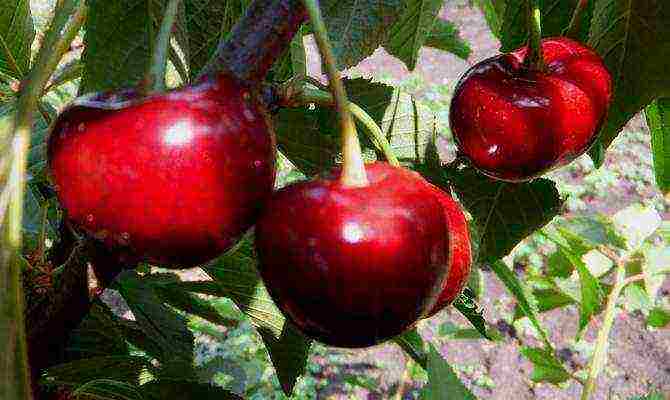
PROS:
- Mid-season
- Very large berries, weighing up to 15 g
- Taste and commercial qualities are excellent (the fruits have a rich red color, glossy shine, the pulp is dense, fleshy, juicy)
- Tasting score 4.5 points
- Duration of fruiting 20 years
MINUSES:
- Berries with heavy precipitation are subject to shedding
- Requires additional pollination
- Low resistance to fungal diseases and garden pests
Top pollinators: Early ripening, Burlat, April, Household, Early Bigarro
Ovstuzhenka
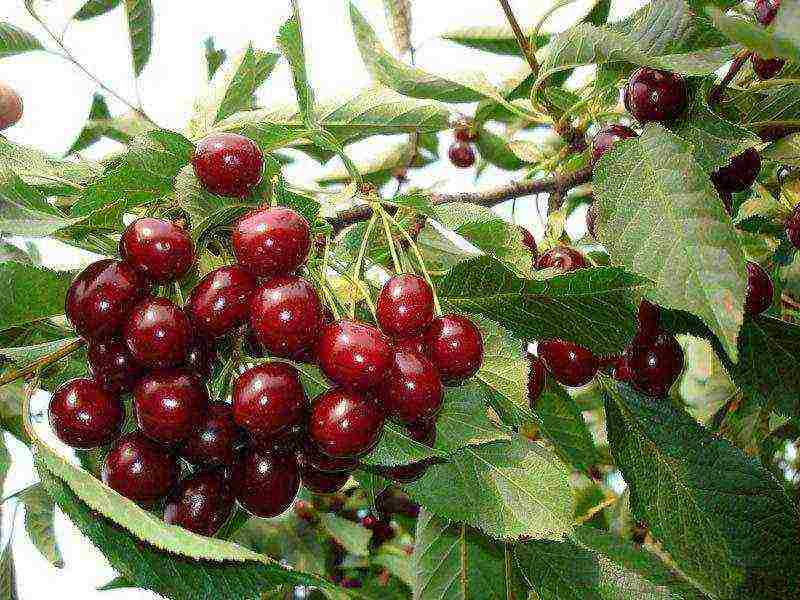
PROS:
- Early ripening of the crop
- It does not require special care
- Medium-sized tree, with a rapid growth rate
- Large berries, weight up to 7 g
- The pulp is sweet enough, juicy
- The color of the berries is dark burgundy
- Product and taste characteristics are high
- Disease resistance is good
- High frost resistance
MINUSES:
- Average yield, on average 15 kg per tree
Regina
PROS:
- Late-ripening variety
- The size of the tree is medium, the growth is gradual
- Does not create difficulties in care and harvesting
- High indicator of presentation and taste
- Berries are not afraid of transportation
- The structure of the berries is firm, the pulp is tasty and aromatic
- The size of the fruits is large, their weight reaches 10 g
- The level of frost resistance is sufficient
- Disease resistance to garden pests is excellent
MINUSES:
- Low rate of resistance to viral diseases
- Requires additional pollination
Pollinators: Karina, Bianca, Sylvia, Nephris, Coral Lotivka
Bull heart

PROS:
- Large-fruited, average berry size 8 g
- The color of the fruit is dark burgundy, the pulp is medium density, the skin is moderately dense with a smooth surface
- Type of separation from the stalk dry
- Universal purpose of fruits
- High degree of productivity
- The size of the tree is medium, but there are also tall plants.
- The degree of frost resistance is good, up to - 25 degrees
- Not susceptible to coccomycosis
MINUSES:
- Low transport rate despite dense skin
- Berries have a short shelf life, processing is required as soon as possible
- Self-infertile variety
Top pollinators: Tyutchevka, Iput, Ovstuzhenka
Yellow

PROS:
- Late ripening of berries
- Increased winter hardiness
- Excellent taste (the pulp is amber, dense structure, juiciness and pronounced aroma)
MINUSES:
- The degree of transportability is low
- The pulp does not separate well from the bone
- Additional pollination required
- Exposed to the invasion of the cherry fly
Pollinators: Bagration, Napoleon pink. Denissena yellow, Cassini early
Early pink

PROS:
- Early ripeness of fruits
- Taste characteristics are high (the pulp is distinguished by a creamy color, the structure is medium-dense, the juice is transparent)
- High resistance to low temperatures
- A fairly good level of resistance to monoliosis, coccomycosis
- Dessert type of berries
- High yield rate, up to 40 kg per tree on average
MINUSES:
- Berries are medium in size, their weight reaches an average of 5 g
- Trees grow up to 5 m
- Low rate of crop transportability
- Poor keeping quality of berries, processing is required in a short time after full ripening
Fatezh
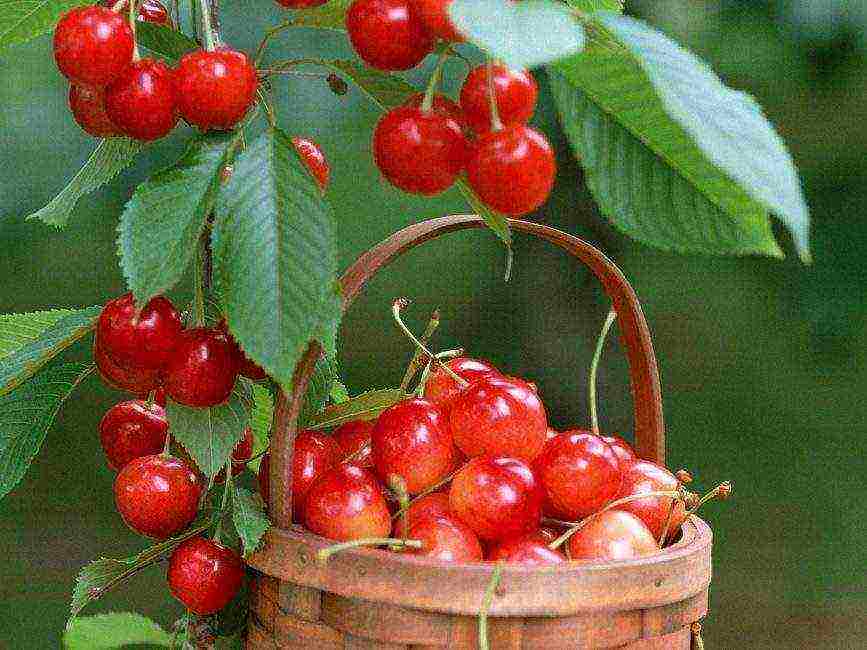
PROS:
- Large-fruited, their average weight is 4.5 g, maximum 6 g
- Fruit tasting score 4.7 points
- The pulp separates easily from the bone
- Fruiting begins at 3-4 years of life of the tree
- The yield indicator reaches 50 kg per tree per season
- The level of winter hardiness is high -30 degrees
- Not susceptible to fungal infections, coccomycosis, moniliosis
- Berries are not afraid of long distance transportation
MINUSES:
- Additional pollination required
Recommended pollinators: Chermashnaya, Iput, Revna, Crimean, Raditsa.
Leningrad black

PROS:
- The variety is medium-sized, spreading crown
- The first crop can be harvested in the third year after planting in a permanent place, in June
- Tasting assessment of the harvest 4.2 points
- The taste and market characteristics are high (the average weight of berries is 5 g, the color is dark burgundy, the pulp is sweet, juicy, there is a slight bitterness)
- The purpose of the fruits is universal, excellent for fresh consumption, and for compotes, jam
- High rate of resistance to garden pests and various diseases
- The variety is unpretentious in care
- The increased degree of frost resistance, withstands low temperatures up to -30 degrees
MINUSES:
- Self-fertile variety
- Additional pollination required
Pollinators required: Leningrad yellow, Leningrad pink, Red dense, Fatezh Berries are prone to cracking, with excessive moisture.
Dybera black
PROS:
- High level of productivity, most often up to 90 kg of tasty and aromatic berries are removed from trees, but under favorable conditions, 170 kg of harvest can be removed from one tree
- Fruits are large in size, their average weight is 6 g
- The pulp is of medium density, juiciness, dark burgundy color, there is a slight sourness
- The frost resistance index is quite high, up to -30 degrees
MINUSES:
- Poor resistance to negative temperatures
- Mature trees reach a height of almost 6 m, which makes them difficult to care for and harvest
- The tree begins to bear fruit 5 years after planting in a permanent place
- Requires additional pollination
- Insufficient immunity to various types of diseases, including fungal, to garden pests
- Regular pruning of the crown is required
Recommended pollinators: Drogana yellow, Bull heart, Napoleon pink, Fatezh,
Cordia
PROS:
- "Queen" of late varieties
- Universal fruits
- Taste and commercial characteristics are high
- Berries are large enough, their weight can reach 8-10 g
- Color carmine black, skin tone bronze
- Fruits are not prone to cracking, do not rot
- Excellent long-distance transportation
- When grown on vigorous rootstocks, the variety is characterized by rapid growth.
- Productivity is regular, fairly high
MINUSES:
- The variety is self-fertile, additional pollination is required
- There is a need for short pruning, the growth of shoots is significantly enhanced
- Average winter hardiness
- The crop is moderately resistant to cracking
Top pollinators: Van, Summit, Karina, Regina, Burlat.
Tyutchevka
PROS:
- Medium late harvest ripening
- Medium-sized tree, semi-spreading crown, sparse, spherical
- The beginning of the fruiting period falls on 3-4 years of plant life.
- The berries are medium in size, their weight is 5-6 g, but under favorable growing conditions they can reach 7 g
- Taste and commercial characteristics are excellent (the color of the pulp is dark red, the structure is dense, the aroma is pronounced)
- Tasting assessment of the harvest 4.9 points
- The crop is not afraid of transportation over long distances, the keeping quality of the fruits is good
- Resistance to major diseases is good
- The average productivity index is over 97 c / ha, with proper agricultural technology this indicator can reach 275 c / ha
- High level of resistance to moniliosis
MINUSES:
- Low self-pollination rate, up to 6%
- Average degree of resistance to clasterosporium disease, coccomycosis
Top pollinators: Iput, Raditsa, Revna, Ovstuzhenka
General's
PROS:
- Variety with medium-late ripening of berries
- The size of the fruits is large enough, their weight is 9-12 g
- The color is yellow, there is a carmine blush
- The pulp stands out with a sweet and sour taste, dense structure, very juicy
- Tasting score - 4.6 points
- The indicator of drought resistance and frost resistance is very high
- Fruiting begins 3 years after planting in a permanent place
- Unpretentiousness when growing
- Resistance to typical diseases and garden pests is sufficient
MINUSES:
- Fruits cannot retain their taste and marketability for a long time, they do not tolerate long-distance transportation
Pollinators: Tyutchevka, Ovstuzhenka, Iput, Crimean, Lapins
Italian
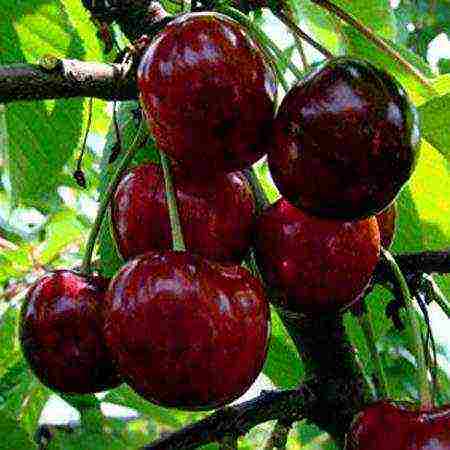
PROS:
- Self-fertile variety
- Fruits ripen early
- Taste and marketable qualities are excellent (the color of the berries is deep red, the pulp is moderately dense, tender, fleshy, it separates well from the stone)
- Large fruits, weight up to 6 g
- High productivity index
- Resistance to major diseases and garden pests is high
- Good frost resistance, up to - 28 degrees
MINUSES:
- There are no obvious shortcomings, based on the reviews of gardeners
Bakhor

PROS:
- The crop ripens early, in the first - in the second decade of May
- The tree grows very quickly, the degree of leafiness is medium, the crown is round
- Fruiting period begins in the fourth year after planting in a permanent place.
- The size of the fruits is quite large, 8-9 g, their color is dark red, wide-heart shaped
- The color of the pulp is dark red, the structure is medium density, very juicy, it has a sweet taste, there is a slight sourness
- The pulp separates well from the stone
- Due to the dense skin, the crop is not afraid of transportation over long distances, it retains its presentation for a long time
- The fruits can be used both for fresh use and for compotes, jams, preserves.
- Tasting score 5 points
- Dessert type harvest
- Planting material is grown from seedlings
- The indicator of resistance to fungal diseases is good
- Frost resistance is sufficient, up to - 25 degrees
MINUSES:
- Vigorous, height 5-6 m
- The yield indicator is average, up to 45 kg of fruits can be removed from one tree
Farewell

PROS:
- Cherries with early ripening, are very popular among gardeners and consumers.
- It is appreciated for its unpretentious care.
- Excellent taste of fruits, large-fruited, high rate of drought and winter hardiness
- High yield rate, up to 95 kg of harvest is removed from one tree
- Fruits are excellent for fresh use, for winter harvesting
- The size of the berries is large enough, weight up to 13 g
- The color is red, the color of the flesh is yellow
- The taste is sweet, harmonious, the aroma is pronounced, there is a wine-sweet aftertaste
- The pulp is easily separated from the bone
- The tasting score is 4.5 points
- The variety is distinguished by its early maturity
- The yield is high, after 10 years the figure is about 100 kg
- Thanks to the dense skin that protects the pulp well, the crop can be stored for a long time and is not afraid of transportation over long distances
- High degree of resistance to coccomycosis
- Increased degree of frost resistance
MINUSES:
- The tree is very vigorous, which makes it difficult to pick berries
- The variety is self-fertile, additional pollination is required.
- Average indicator of resistance to fungal infections
Pollinator varieties: Donetsk coal, Valery Chkalov, Donetsk beauty, Sister, Valeria, Donetsk Yaroslavna, Ethics, Rannnya rovinka, Aelita, Annushka, Donchanka
Yaroslavna

PROS:
- The tree is medium-sized, its height does not exceed 3.5 m
- Does not require special conditions for growing, care
- The yield indicator is high, annual
- Type of separation from the stalk dry
- Taste and marketable qualities are excellent
- Fruit size is large, weight is 8-9 g
- The pulp is very sweet, pleasant, of medium density, red in color
- The color of the cherry pomegranate is red, the stone is small in size, it separates well
- The increased degree of frost resistance, drought resistance, resistance to coccomycosis
- Berries do not crack in high humidity conditions
- Transportability is good
MINUSES:
- The variety is vigorous, the crown is spherical - spreading, the branches are curved
- Additional pollination required
- Average indicator of resistance to fungal infections
Pollinators: Ovstuzhenka, Raditsa, Iput, Chermashnaya, Fatezh.
7.5 Overall Score
After reviewing the description of cherry varieties, having studied their strengths and weaknesses, you can choose the most suitable option for your personal plot. It is recommended to purchase seedlings in specialized retail outlets, while you need to pay attention to the presence of damage on the trunk and root system. We tried to collect for you the most popular varieties of cherries and give all the necessary information on them. If you disagree with these ratings, leave your rating in the comments with the reasons for your choice. thank you for your participation. Your opinion will be useful to other users.
Add your review | Read reviews and comments
The climatic conditions in the south of Russia are the most favorable for the cultivation of sweet cherries. The first winter-hardy varieties, bred in the last century, had low taste and yield. In recent decades, Russian breeders have been working on developing new varieties that bear fruit well in the cold. Hybridization of southern varieties is aimed at improving the productivity of trees, which now reaches 18 tons per hectare.
1 Characteristics of varieties
Cherries are divided into several groups according to various parameters, which help to choose the most suitable variety for specific conditions and requirements.

According to the size of the crown, they are divided into vigorous and medium-sized. In cold winters, in the Urals and Siberia, the height of the cherry crown is a decisive factor when choosing a variety, since trees need shelter during the cold season.
What are the best cherry varieties to choose for the Moscow region?
2 By the rate of ripening
According to the rate of ripening of berries, the best varieties of cherries are divided into 3 groups.
| Early (end of June) | Medium-fruit (mid-July) | Late fruit (early August) |
| Annushka, Drogana yellow, Aelita, Valery Chkalov, Valeria, Melitopol early, Muscat, Large-fruited, Yaroslavna, Ariadna, Vyznannya, Gronkavaya, Zaslonovskaya, Debut, Zhurba, Iput, Household, Early pink, Chermashka improved, Caucasian , Morning of the Kuban | Scarlet, Daibera black, Dagestanka, Zemfira, Melitopol black, Festivalnaya, Ramon Oliva, Franz Joseph, Kid, Joy, Revna, Sinyavskaya, Ovstuzhenka, Leningrad pink, Rechitsa, Narodnaya, Pink pearl, Tyutchevka, Muscat, Fatezh, Orlovskaya pink, Krasavitsa pink , Poetry, Golden Loshitskaya, Ruby Kuban, Victory, South, North, Black eyes | Donchanka, Bryansk pink, Red dense, Leningrad black, Poppy, Scarlet, Radiant |

The best varieties of zucchini for the middle lane, northern regions and Siberia
3 By the first year of fruiting
Among the frost-resistant varieties, cherries have been bred, which are capable of bearing fruit already for 3 years. More productive southern varieties begin bearing fruit later.
| Early (3-5 years) | Average (6 yrs) | Late (7 yrs) |
| Southern: Annushka, Bereket, Winklera white, Zhabule, Zhannet, Krasa Kubani, Poppy, Krasnodar early, Nalchanka.
For the center of Russia: Adelina, Ariadna, Kozlovskaya Michurina, Bryanochka, Orlovskaya pink, Memory of Pokrovskaya, Poetry, Rechitsa. Winter-hardy: Iput, Ovstuzhenka, Odrinka, Tyutchevka, Fatezh, Chermashnaya |
Scarlet, Bigarro Drogana yellow, Orlovskaya Fairy, Gold, Napoleon pink, Franz Joseph, Bigarro | Recordist, Cassini red, Show, Lucie yellow, Napoleon, French black |
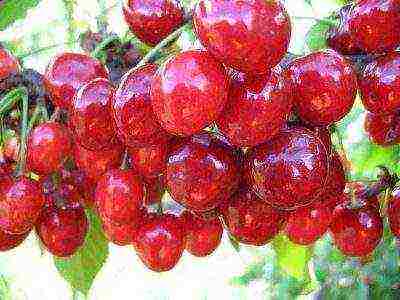
The best raspberry varieties for Russia
4 By pulp
According to the density of the pulp, the varieties of bigarro (dense, crispy fabric) and gini (tender and soft) are distinguished. Bigarro fruits are mainly intended for processing, they are well transported and can be stored for a long time. Ginis are eaten fresh. Most often, gini varieties are of early and medium ripening.
| Bigarro varieties | Gini varieties |
| Annushka, Aelita, Valery Chkalov, Vasilisa, Dagestanka, Caucasian, Large-fruited, Melitopol black, Franz Joseph, Yaroslavna | Scarlet, Valeria, Beauty of Kubani, Ramon Oliva |
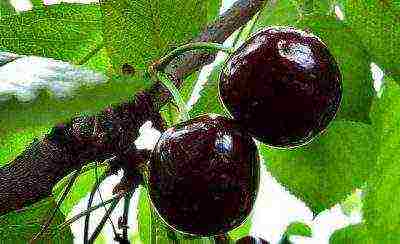
If joints or back hurt, include in your diet ...
5 To taste
Berries to taste: sweet and sour, sweet and dessert. Some of the most winter-hardy varieties have a taste that is not inferior to southern varieties.
| Sweet and sour | Sweet | |
| Oryol pink, Early pink, Poetry, Pink pearls, Julia, Jeannette | Southern: Bereket, Mak.
For the central part of Russia: Ariadna, Gronkavaya, Bryanochka, Leningradskaya black, Rechitsa, Pamyat Pokrovskaya, Teremoshka. Increased frost resistance: Chermashnaya, Iput, Bryansk pink, Revna, Tyutchevka, Ovstuzhenka, Odrinka |
Fatezh, Adelina, Alaya, Valery Chkalov, Napoleon black, Caucasian, Morning of the Kuban, Annushka |
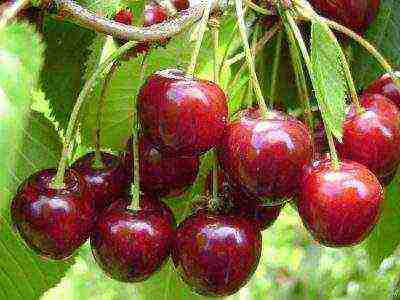
6 Cherry zoning
In Russia, about 180 varieties of sweet cherry are being tested in various zones, of which 78 are recommended for cultivation by the Federal State Budgetary Institution "State Sort Commission". 21 varieties can be grown in the Central region of Russia.
Which varieties are suitable for each region:
| Region | Regional centers and republics | Names of varieties of cherries |
| Central | Bryansk, Smolensk, Vladimir, Tver, Kaluga, Moscow, Ryazan, Ivanov, Smolensk, Tula | Chermashnaya, Bryanochka, Iput, Bryansk pink, Gronkavaya, Revna, Odrinka, Astakhov's favorite, Ovstuzhenka, Ryazan's gift, Stepanov's gift, Raditsa, Rechitsa, Teremoshka, Tyutchevka, Fatezh |
| Black earth | Belgorod, Voronezh, Kursk, Lipetsk, Orel, Tambov | Homeland, Adeline, Poetry, Ariadne, Gronkavaya, Iput, Italian, Early pink, Red dense, Beauty Zhukova, Oryol pink, Leningrad pink, Gift of Ryazan |
| North Caucasian | Adygea, Stavropol, Dagestan, Ossetia, Ingushetia, Kabardino-Balkaria, Krasnodar and Rostov, Chechen Republic, Crimea | Scarlet, Alexandria, Amulet, Annushka, Velvet, Valery Chkalov, Korvatsky's favorite, Dagestan woman, Magician, Early Dagestan, Goryanka, Jeannette, Vitivnitsa, Noble, Karadag, Caucasian, Large-fruited, Beauty of Kuban, Dawn of the east, Krasnodar early, Contrast, Poppy, Melitopol black, Nalchanka, Prizerka, Rosinka, Ruby Kuban, Italian, Sasha, Morning star, Bereket, Delight, Morning of the Kuban, Chernokrymka, Franz Joseph, The Queen of Spades, French black, Vesnyany naspivy, Euphoria, Etok beauty, South, Golubushka , Yaroslavna |
| Nizhnevolzhsky | Astrakhan, Volgograd, Saratov, Kalmykia | Early pink, Dybera black |
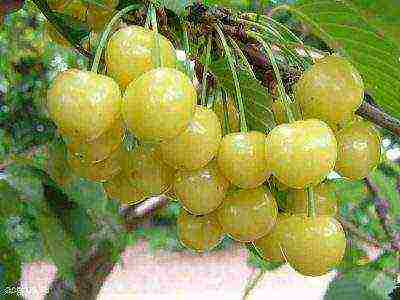
7 Southern varieties
Southern varieties of sweet cherries, grown in the Krasnodar and Stavropol Territories, in the Crimea are distinguished by the greatest diversity, large-fruited and yield. The productivity of a sweet cherry depends on its ability to lay the greatest number of buds. The most promising in terms of productivity are the following varieties:
| Early | Medium-fruited | Late-fruited |
| Sasha, Melitopol early, Kashtanka | Melitopol black, Demeter, Sorceress | Scarlet, Gift of abundance, Polyanka, French black, Large-fruited |
The most stable yield under climate fluctuations is given by the varieties Alaya, Kavkazskaya, Volshebnitsa, Dar Izobiliya, Sasha, Rubinovaya Kubani, Melitopol black, Large-fruited, Annons (up to 55 kg per tree).
Frost resistance of southern varieties is different, they are divided into 4 groups.
| Early frosts in late autumn | Low temperatures in the middle of winter | Temperature drops in winter | Spring frosts |
| Daibera black, Yaroslavna, Donetsk giant, Romance, Drogana yellow, Melitopol black, Napoleon white, Krasnodar early | Ruby Kuban, Caucasian improved, Napoleon white, Krasa Kuban, Drogan yellow, Dyber black | Melitopol black, Romance, Krasnodar early, Joy, Beauty of Kuban, Napoleon white | Caucasian, Gift of abundance, Poppy, Oryol pink, Napoleon white, Drogana yellow |
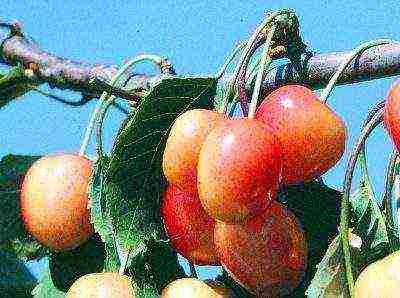
The most drought-resistant varieties are the varieties Alaya, Volshebnitsa, Mak, Sasha, Utro Kubani and their hybrids.
Large-fruited varieties with a mass of 8-10 grams include Alaya, Annushka, Poppy, Cordia, Yuzhnaya, Sylvia, Morning of Kuban, Poetry, Black eyes, Valery Chkalov, Prestizhnaya, June early. The size of large-fruited cherry berries can reach 12-15 grams. The most productive (10-12 centners per hectare) are Rubinovaya Kuban, Clear sun, Poppy, Krasnaya devitsa, Alaya, Gift of abundance.
8 Winter-hardy varieties for the middle zone of the country
The first varieties of cherries with increased resistance to low temperatures were bred by IV Michurin in the 19th century: Kozlovskaya, Pervaya swallow, Pervenets. These varieties were used in the future for crossing and obtaining varieties of sweet cherries with improved palatability of the fruit. Michurin's work was continued by Doctor of Sciences F.K. Teterev, who managed to develop winter-hardy varieties with sweet, juicy berries in the conditions of the Leningrad region: Leningrad black and yellow, Zorka. Since these varieties could not be used for growing on an industrial scale, they were forgotten for many years.
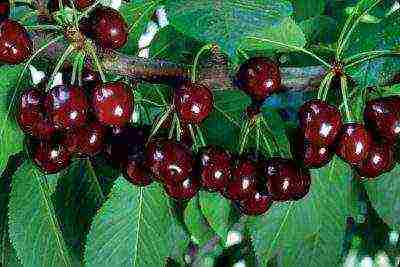
The most common modern varieties bred for the cold climatic conditions of central Russia are the cherries of Doctor of Sciences M.V. Kanshina.In Bryansk, in an experimental farm, she managed to collect a collection of 200 "northern" varieties of sweet cherries. The most winter-hardy cherries are varieties of A.I. Evstratova - Chermashnaya and Fatezh, selected from several thousand hybrids of Leningrad yellow. These varieties were successfully zoned at the beginning of the XXI century. In addition to them, the varieties Ovstuzhenka, Krymskaya, Iput, Odrinka and Bryanskaya rozovaya showed good frost resistance.
They can be successfully cultivated in the Moscow region, and subject to certain agrotechnical techniques - in the Saratov, Samara and Ulyanovsk regions. In the North-West region, these varieties freeze out in cold winters - the unprotected crown of the tree is most often affected. In order to prevent this from happening, the cherries form a creeping crown and additionally cover them for the winter. The creeping crown also makes it easier to pick cherries. Often, flower ovaries are damaged by frosts in late spring, therefore additional protection of trees is required at this time of the year. If possible, cherries should be planted near shelters (fences, walls of buildings), so that they are not blown by the winds, but receive a sufficient amount of light. Not only trees planted in more northern regions, but also in central ones, suffer from spring temperature drops. To protect the cherry trunk from cracking, it must be whitewashed.
Description of the most winter-hardy varieties:
- An adult Fatezh cherry tree forms a drooping crown. This variety is bred from Leningradskaya yellow. The leaves are large, serrate at the edges. This variety is medium-early, medium-sized. The mass of rounded red berries is 4.4 g. The flesh is tender, the color is light pink. Dessert fruits, with a high content of sugar and vitamin C. Possesses high frost resistance at the level of Vladimir cherry, withstands temperatures up to -32 degrees. Resistant to fungal infections. On average, the yield is 131 c / ha, and the maximum yield from a tree is up to 16 kg.
- Chermashnaya varieties ripen very early - in June. Flowering begins May 5-10. Grows quickly and gives berries for 4 years of life. The tree reaches a height of 4.5 m, that is, it is of medium height. The leaves are serrate. Dessert berries, original yellow color, soft and juicy inside. Easily pitted. The berries come off the stalk well without being damaged. The fruits are medium in size, up to five grams. Harvest from one tree - up to 15 kg. It is characterized by good winter hardiness, is weakly susceptible to diseases.
- Cherry Ovstuzhenka begins to bear fruit for 5 years. The tree is medium-sized, with a spherical crown with large leaves. Berries are dark red, oval, dessert, ripen towards the end of June. May crack during humid summer. The yield per hectare is 108 centners.
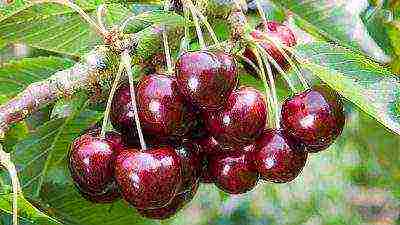
The harsh winters in the nurseries of the Bryansk region in 1995-1997 withstood the varieties of cherries Iput, Bryanskaya rozovaya and Tyutchevka:
- Frost-hardy Bryansk pink bears fruit very late. Berries do not crack, are resistant to rot, medium weight (5 g), well preserved. You can harvest 20-30 kg of berries from one tree. The color of the skin of the berries is pink with specks, and the flesh is light yellow, juicy.
- Cherry Iput is a vigorous tree with a pyramidal crown and large leaves. Bears fruit for 4 years. The berries are heart-shaped, large, dark red. On average, their weight is 6 g. The pulp of the berries is tender, with a sweet juicy taste. The bone from the pulp can be easily separated. Average yield - 105 kg / ha, maximum from a tree - 30 kg.
- Tyutchevka fruits ripen in July. Fruits with high taste characteristics, sweet, with dense, cartilaginous pulp and high content of vitamin C. Their color is dark red. The average weight of berries is 5 g. They are well preserved, but in rainy summers they are prone to cracking.
9 Compact winter hardy cherries
Since in the wild, sweet cherry trees reach 25-30 m in height and up to 50 cm in diameter of the trunk, medium-sized and low-growing varieties of sweet cherries are more suitable for the conditions of the North-West region.One of the new promising varieties obtained as a result of radiation mutation of sweet cherry Orlovskaya Yantarnaya is the Malysh variety. It was launched relatively recently - in 2001 and is now being tested. Radiation and chemical mutagenesis are the newest breeding methods that make it possible to obtain a variety of offspring of sweet cherry varieties with great variability of characteristics.
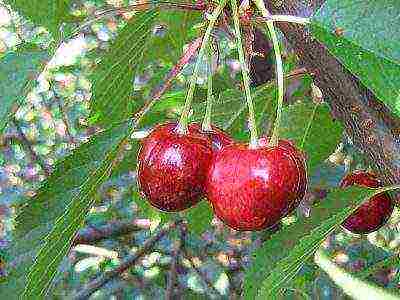
Sweet cherries of the Malysh variety reach a height of less than 3 m (which is a rarity for this fruit crop), and have a spreading pyramidal crown. Due to its low growth, the tree can be covered with non-woven material during the May frosts. In terms of sweetness, the fruits are not inferior to the Iput variety and are dessert. The berries begin to ripen in the second half of July. Cherry begins to bear fruit already in the fourth year. The variety is resistant to coccomycosis, which often affects cherries. The mass of Malysh's berries is on average small - up to 4 g, but some specimens reach 6 g, the color is bright yellow, the pulp is medium-dense, the juice is colorless. With proper agricultural technology, the yield reaches 10 kg per tree specimen. The Malysh variety has high winter hardiness (up to -37 degrees).
The cherry variety Poetziya, bred in the Research Institute of Breeding, grows relatively low (up to 3.5 m).
10 Growing in the Urals and Siberia
The main problems when growing sweet cherries in central Russia are the freezing of trees in winter at temperatures below -27 degrees, sudden temperature fluctuations, due to which the trunk cracks (frost cracks), damage to flower buds during spring frosts (below -25 degrees). However, some agricultural techniques make it possible to grow cherries in the Middle Volga region, the Urals and even in the north-west of Siberia. In this case, there is no need to talk about a good harvest, but it is quite possible to please your household with a small amount of cherries grown in your personal plot.

Good results when growing cherries in the northern regions are shown by the same grafting method as for local cold-resistant varieties of cherries. In autumn, grafted cherries are bent to the ground and covered with spruce branches. In winter, it is necessary to "spud" them with snow several times. At a depth of up to half a meter under loose snow, the soil temperature, even in severe frost, can stay at 10 degrees, which contributes to the survival of varieties intended for central, warmer regions.
Winter hardiness of cherries also depends on the composition of the soil - trees freeze faster on heavy, clayey soils. Therefore, before planting, it is necessary to add sand to the soil.
At the time of flowering, when cold snaps are possible, it is recommended to cover trees with non-woven material. Since insects are needed for pollination of cherries, 1-2 small holes are left in the shelter for their flight.

Frost-resistant compact varieties of sweet cherries are also promising. At the end of summer, they need to prune branches in order to stop their growth, so that the tree does not waste its energy on unnecessarily thickening the crown. With the formation of a creeping crown in such trees and their protection for the winter, it is possible to obtain more abundant harvests in the north of Russia.
11 Self-fertile cherries
All Russian varieties are self-fertile, that is, they need cross-pollination. Therefore, in the garden area there should be at least 2-3 cherry trees blooming at the same time, preferably of different varieties and taking into account their best pollination. You can plant several shoots in the crown of one tree. A slight self-fertility of plants (up to 14% of flower ovaries) is observed in the following varieties:
- Zhabule;
- Ariadne;
- Early Cassini;
- Alexandria;
- Bigarro cream;
- Euphoria;
- French black;
- Jealous (up to 5% self-fertility).
Self-fertility can vary depending on climatic conditions. Under unfavorable conditions, partially self-fertile cherries become completely sterile.
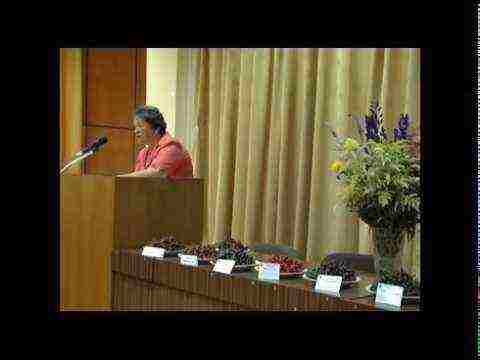
Each variety has its own pollinators.One of the best and most versatile varieties for pollination, which also has a high winter hardiness, is the Crimean cherry.
Self-pollinated varieties have been bred abroad (Big Star, Celeste Sumpaka, Lapins, New Moon Sumini, Sabrina SUMN314CH and others), which allows trees to be sheltered during flowering in order to protect them from adverse atmospheric influences without prejudice to pollination and fruit ovaries. In Russia, such varieties do not yet exist, but in the future it is possible to obtain domestic hybrids based on them, which also have the qualities of the best winter-hardy cherries.
Many people love sweet cherry, so it is grown everywhere in gardens and summer cottages. The culture is not picky, but it will not tolerate neglect. She needs regular watering, pruning, feeding, and sometimes insulation for the winter. Early varieties of cherries: white and red, fruitful and large-fruited will be described below in the article.
What are the features of early cherry varieties?
Early varieties of cherries are the most famous and popular trees for planting, because they give early harvests. Early fruiting makes life easier for the gardener - you can quickly make preparations for the winter, sell a lot more berries, and also eat plenty of cherries and replenish the supply of vitamins for the coming months!
But besides the ripening period, are there any common characteristics in the early varieties of sweet cherries? There is one common similarity that every gardener should be aware of. Usually, all such trees need a pollinator tree to grow nearby. Without it, there will be either very little or no fruit.
It is necessary that a pollinator tree grows nearby
Otherwise, these species are too diverse: color, berry size, yield, type of cultivation and characteristics they may be completely different. It is possible, perhaps, to note the endurance to return cold, but not all gardeners will agree with this, because it is the early varieties of cherries (flowers and buds on them) that often freeze out during spring frosts.
What early varieties of sweet cherries have high yields?
Productivity is the first thing that is important if early cherry varieties are planted for a large family, with an abundance of relatives and friends, or for sale. In these cases, 20-30 kg of yield from one tree is not enough, so it is worth choosing more productive varieties of early cherries.
- "Household" annually produces up to 85 kg of berries from a tree. Fruiting begins from 5-6 years, berries ripen from the beginning of June. The tree grows up to 4 meters, the crown is not very thickened, round. Berries up to 5.5 grams, with tender, creamy pulp. The color of the berries is yellow, with a rich red blush. High transportability. Pollinators: Vinka, Skorospelka, Valery Chkalov.
- Valery Chkalov - an early variety of sweet cherry, has a yield of up to 60 kg / tree and gives large berries weighing 7-9 grams each. The shape is rounded, the color is burgundy, and when overripe is almost black. Ripening has been observed since the beginning of June. The taste is sweet, the tasting score is 4.5 points. Resistance to mild moderate temperatures and some diseases is observed. The best pollinators include: "Skorospelka", "Zhabule", "June early".
- "Melitopol early" gives 50-60 kg of berries from each tree. Berries 6-7 grams, oval, dark red. The pulp is dense, juicy, sweet, the aroma is strongly pronounced. The stone is large, it separates from the pulp without problems. The use is universal. Pollinators: Valery Chkalov, Ruby Early, Bigaro Burlat.
- "Leningradskaya black" gives 40 kg of harvest per tree annually. Fruiting in 3-4 years, the harvest ripens around the beginning of July. The tree is tall with a massive crown. Differs in cold resistance. Fruits up to 5 grams, sweet, juicy, ovoid, slightly flattened. The color is dark scarlet. The taste is bright, full-bodied with a honey flavor. Most often used for processing for the winter. Cherries "Veda", "Revna", "Tyutchevka", "Michurinka" are planted nearby as pollinators.
- "Maiskaya" - an early variety of sweet cherry, has an average yield of 40 kg per tree.Fruiting from 4 years old, the crop is usually harvested from late May or early June. The berries can be said to be small, since their weight ranges from 2 to 4 grams. The color is bright red. A feature of the variety can be called resistance to frost and disease. It is used exclusively for fresh consumption and desserts, because in conservation the variety completely loses its taste, there is neither sweetness nor aroma. Poorly transported. Pollinators can be: "Dzherelo", "Early Duki", "Melitopol early".
Large varieties of cherries
Early varieties of sweet cherries can be roughly divided into small-fruited, medium and large-fruited. Of course, the latter are the most convenient for eating and processing. Also, it is the large varieties of cherries that attract buyers in the market and in stores, and they can be sold at a higher price.
- "Farewell" has a yield of 60 kg per tree annually with good care. The tree is of medium height, the crown is spreading, with an abundance of foliage. Fruiting from 4-5 years, fruit ripening - mid-June. The berries are dense, large - 14 grams, dark red. Sweet wine taste, strong aroma. High transportability. Pollinators: "Donetsk beauty", "Donetsk coal".
Large varieties of early cherries
- "Story" it is valued precisely for its large berries (10-12 g) and a pleasant, sweet taste, although the pulp is moderately juicy. The cherry color is scarlet, the shape of the berries is almost round. Fruiting begins from the 5th year, and the annual harvest ripens from the beginning of June. Pollinators include: "Ovstuzhenka", "Tyutchevka" and "Iput". Resistance to transportation, frost and berry cracking is noted.
- "Yaroslavna" - an early variety of sweet cherries, has rather large berries up to 9 g each. The bone is small, it can be separated without any problems. The tree grows tall, the crown is massive. Differs in good frost resistance. The yield is 20-30 kg per tree every year. Ideal for juicing. Fruiting from the beginning of July. Pollinators: Annushka, Donetsk Beauty, Valeria.
- "Ovstuzhenka" - a small tree with a not wide crown and an abundance of leaves. Cherries 4-6 g, burgundy. A pleasant feature of the variety is that the stone is separated without problems. Productivity 25-35 kg annually. Ripens from the second half of June, and fruiting is observed only from 4-5 years. Sweet cherries-pollinators: Tyutchevka, Revna, Iput, Bryansk pink, Pink pearl.
Early varieties of yellow cherries
Early varieties of sweet cherries with yellow berries are not very expensive on the market, as they quickly deteriorate. But if you grow them in your own garden, you can get not only good berries for conservation, but also an abundance of vitamins, because yellow cherries are very useful for the body.
Early varieties of yellow cherries
- "Chermashnaya" has a tall tree with a thickened, elongated crown. Berries up to 5 grams are yellow, ripen from the beginning of June. The pulp is fleshy, with a high proportion of juice and a honey aftertaste. The pits can be separated without problems, which makes processing easier. Diseases and frosts are easily tolerated. Pollinators: "Iput", "Bryansk pink", "Fatezh", "Leningradskaya black".
- "Mlievskaya yellow" - an early sweet cherry variety, ripening from mid-June. Berries 5-6 grams, yellow, with shiny skin. The main difference with this variety is that it does not require pollinators. Average winter hardiness. The first fruiting can be expected for 4-5 years. Suitable for processing and fresh consumption.
- "Summer resident" ripens from mid-June. The berries are light yellow, weighing 7-11 g, heart-shaped. The stone separates well from the pulp. Bears fruit since 4 years. The tree grows low, the crown is spreading. Pollinators: "Talisman", "Yellow Drogana", "Melitopolskaya".
VIDEO - Very tasty cherries "Priusadebnaya"



